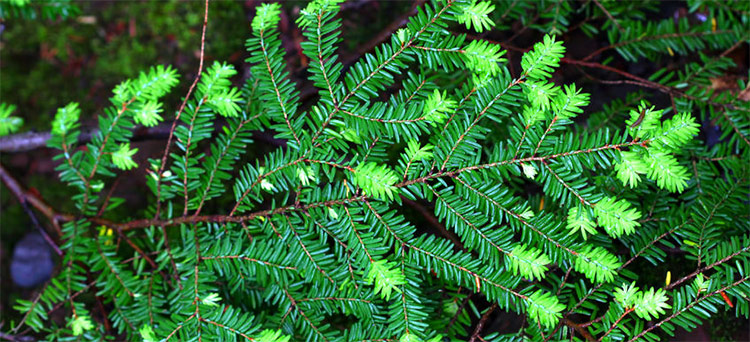Hemlock Essential Oil
Tsuga canadensis / Pinus canadensis

Description
Hemlock Essential Oil is also known as Eastern Hemlock and Hemlock Spruce. Because its botanical name is Tsuga canadensis, Hemlock is also sometimes referred to as Tsuga Essential Oil. As with all essential oils, it's important to doublecheck the botanical name of the oil that you are working with.
I adore the aroma of most conifers, and am particularly drawn to the fresh, crisp, needle aroma of Hemlock Essential Oil.
Aromatically, if you enjoy the aroma of fir and spruce oils, you should be pleased with the aroma of Hemlock Essential Oil. It's especially lovely to work with around Christmas and winter holidays, but its fresh aroma and therapeutic properties makes it wonderful to blend with throughout the year.

As a conifer, it's not surprising that Hemlock Oil is abundant in monoterpenes and also contains about 30-35% esters. Due to its monoterpene content, the oil will be more prone to oxidation. Therapeutically, Hemlock Oil is anti-microbial and is helpful as a decongestant and expectorant.
Emotionally, I personally find Hemlock Essential Oil to be energizing and stimulating when I feel lethargic, but I don't find it to be over stimulating. I find it beneficial to include in diffuser blends intended to help me remain focused, optimistic, calm and balanced.
For more information about spruce and conifer oils, read AromaWeb's Guide to Coniferous Essential Oils.
Hemlock Essential Oil Benefits and Uses
- Muscular Aches
- Bronchitis
- Coughs
- Colds
- Flu
- Anxiety
- Stress
Source: Julia Lawless, The Encyclopedia of Essential Oils (Updated Edition) (London: Harper Thorsons, 2014), 185-186.
Botanical Name
Tsuga canadensis / Pinus canadensis
Plant Family
Common Method of Extraction
Steam Distilled
Plant Part Typically Used
Color
Clear
Consistency
Thin
Perfumery Note
Top
Strength of Initial Aroma
Medium
Aromatic Description
Hemlock Essential Oil smells fresh, woody and earthy.
Sustainability and Conservation Status
Near Threatened
Source: https://www.iucnredlist.org/species/42431/2979676
To learn more about the conservation status of essential oil bearing plants and how to use the IUCN Red List of Threatened Species, please refer to AromaWeb's Guide to Essential Oils and Sustainability.
Major Constituents
- Isobornyl acetate
- B-Pinene
- Gamma-3-Carene
- (+)-Limonene
- a-Pinene
See Essential Oil Safety for a more complete list of typical constituents.
Source: Private Communication: Rondeau, 1999. Source cited in Robert Tisserand and Rodney Young, Essential Oil Safety (Second Edition. United Kingdom: Churchill Livingstone Elsevier, 2014), 430.
Hemlock Essential Oil Safety Information
Tisserand and Young warn that old and oxidized oils should not be used. Reading Tisserand and Young's full profile is recommended. [Robert Tisserand and Rodney Young, Essential Oil Safety (Second Edition. United Kingdom: Churchill Livingstone Elsevier, 2014), 429-430.]
General Safety Information
Do not take any oils internally and do not apply undiluted essential oils, absolutes, CO2s or other concentrated essences onto the skin without advanced essential oil knowledge or consultation from a qualified aromatherapy practitioner. For general dilution information, read AromaWeb's Guide to Diluting Essential Oils. If you are pregnant, epileptic, have liver damage, have cancer, or have any other medical problem, use oils only under the proper guidance of a qualified aromatherapy practitioner. Use extreme caution when using oils with children and be sure to first read the recommended dilution ratios for children. Consult a qualified aromatherapy practitioner before using oils with children, the elderly, if you have medical issues or are taking medications. Before using this or any essential oil, carefully read AromaWeb's Essential Oil Safety Information page. For in-depth information on oil safety issues, read Essential Oil Safety by Robert Tisserand and Rodney Young.
Shelf Life
Important Information About the Profiles
The essential oil information provided on AromaWeb is intended for basic educational purposes only. The references to safety information, test results, constituents and percentages is generalized information. Essential oils can vary greatly in composition. The data is not necessary complete and is not guaranteed to be accurate. The essential oil photos are intended to represent the typical and approximate color of each essential oil. However, essential oil composition and color can vary based on harvesting, distillation, age of the essential oil and other factors. Profiles for several CO2 Extracts and absolutes are included within the directory, and are denoted as such.
